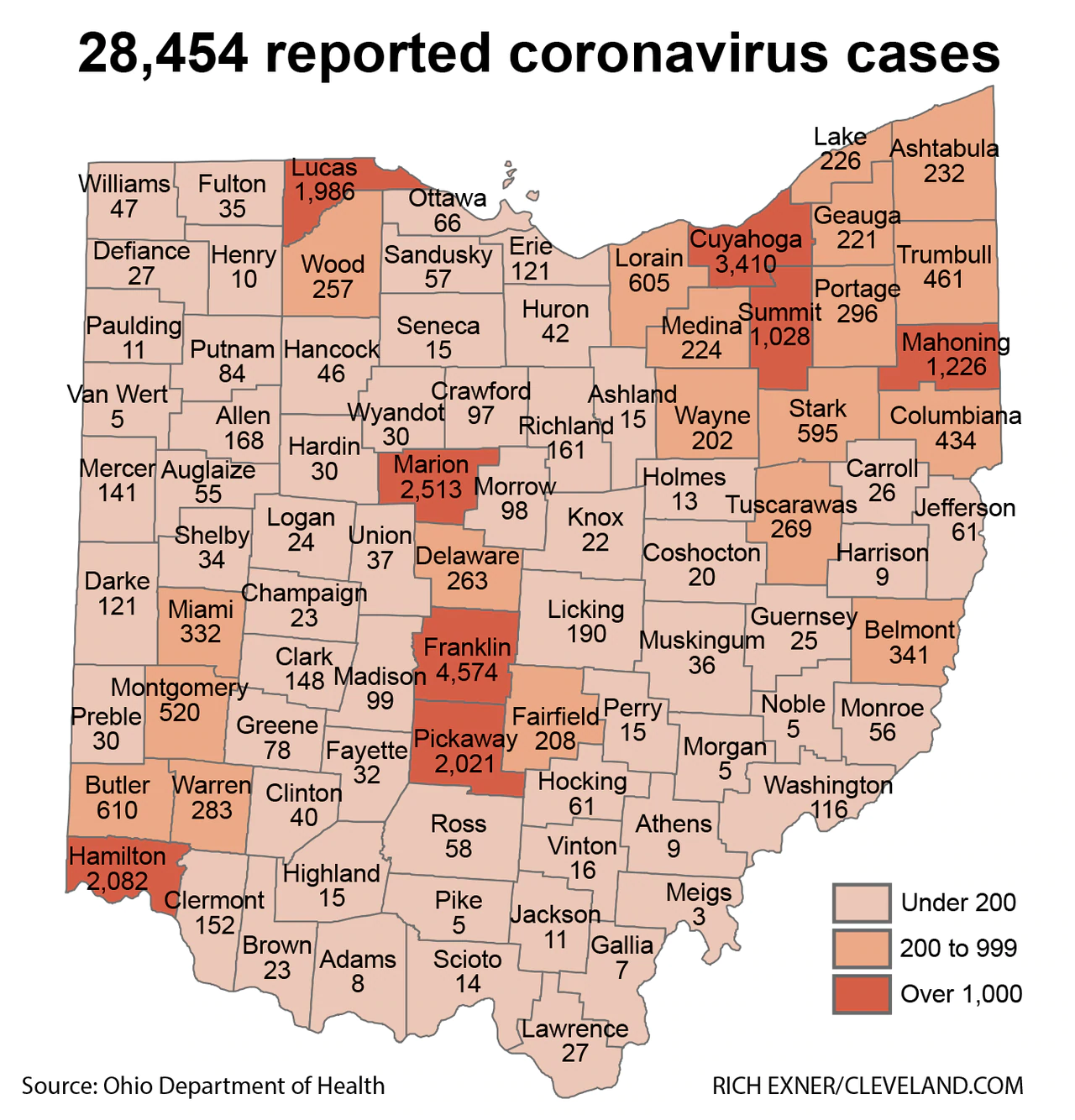COLUMBUS, Ohio – Ohio’s 1,657 known coronavirus-related deaths are spread across 66 of the state’s 88 counties, with total cases now reaching 28,454, the Ohio Department of Health reported Monday.
See Tuesday, May 19, update at this link: Mapping Ohio’s 28,952 reported coronavirus cases.
The death total, which including the first case for Adams County, increased 2% from 1,625 the day before, while the case total was up 1.9% from 27,923.
The number of deaths reported daily for the last week were 32, 15, 29, 47, 79, 16 and 10. The reports lag several days from the actual date of death and sometimes are reported by the state in clusters.
Separately, data from the Ohio Hospital Association said there were 912 coronavirus patients in reporting hospitals across the state. This number has been below 1,000 since Wednesday. The number of patients in intensive care was reported at 367, a count that was last above 400 on May 7.

This chart shows the number of coronavirus patients on a given day, as reported by hospitals to the Ohio Hospital Association. Out-of-state patients are included. Totals for the most recent day or two may be revised later.Rich Exner, cleveland.com
The state’s case total has gone up daily by 531, 449, 520, 597, 636, 471 and 473 over the last week. Higher increases in mid-April were tied heavily to stepped-up testing in prisons, even among inmates without symptoms.
The prison department on Sunday reported 5,364 cases to date (4,415 inmates and 949 staff), 70% of whom have recovered.
The daily increase in total cases has been under 4.2% since April 22. In March the daily increases were often above 20%, and sometimes above 40%.

Ohio reported 531 new cases of coronavirus on Monday.Rich Exner, cleveland.com
Increased testing in recent weeks could cause the number of reported cases to go up, though expanded testing is viewed by Gov. Mike DeWine and other state officials as a key to containing the spread of the virus.
A total of 270,041 tests have been conducted, up 60,888 in the last seven days. In comparison, there were 54,863 tests the previous week, and 34,889 two weeks ago.

These are the number of cases based on the estimated onset dates since April 1 for Ohio’s reported coronavirus cases. Confirmation often is days after the first symptoms, leading to smaller numbers for the most recent days. Prison testing resulted in a spike in mid-April.Rich Exner, cleveland.com
Ohio unlike some other states does not provide information on the number of current cases remaining, excluding those who no longer have coronavirus, saying that information is not available. This information is provided only by the prison department, and by the health department for nursing homes.
Yet health officials have said coronavirus often runs its course in 14 days, longer for the most severe cases, indicating that many known cases no longer exist. Most of the known cases are older.
Among the cases reported to date, excluding those who have died, 5,511 have had an onset in the last two weeks. Nearly four times as many – 21,286 – are older.

Health officials say coronavirus often lasts less than two weeks, though it can be longer for severe cases. This graphic provides a breakdown of the cases reported to date – based on onset before and after two weeks ago.Rich Exner, cleveland.com
The state is now reporting that the onset of symptoms was as early as January for seven cases. Two of those cases were in Miami County, with the others in Lake, Montgomery, Richland, Summit and Warren counties.
The age range for confirmed cases to date is from under 1 to 108, with a median age of 50. The median age for deaths is 80.
Just over half of all deaths (865 of 1,657, or 52.2%) have been to people age 80 and over. This age group accounted for 44% of deaths from all causes nationally in 2017.
About half of Ohioans are under 40, yet only 17 people in this age group are known to have die with coronavirus – 12 in their 30s and five in their 20s.

People age 70 and up account for 77.5% of the known coronavirus deaths in Ohio.Rich Exner, cleveland.com
The counties with the most deaths are Lucas (207), Franklin (177), Cuyahoga (175), Mahoning (148), Hamilton (112) and Summit (112).
For the deaths in which race was reported, 81.1% are white, and 16.8% are black. Yet for total cases, 62.8% are white and 31.4% black. Ohio’s population is 81.9% white and 13% black, census estimates say.

This shows the date of death for Ohio coronavirus victims, though many more recent deaths likely are not included because confirmation lags.Rich Exner, cleveland.com
Among all cases reported to date, 4,998 have been hospitalized, including 1,328 in intensive care units. These totals were 4,921 and 1,305 on Sunday, 4,870 and 1,300 on Saturday, and 4,791 and 1,277 on Friday.
The counties with the most cases are Franklin (4,574), Cuyahoga (3,410), Marion (2,513), Hamilton (2,082) and Pickaway (2,021). Franklin (Columbus), Cuyahoga (Cleveland) and Hamilton (Cincinnati) are Ohio’s most populated counties. Marion and Pickaway have high numbers of prisoners with COVID-19, as do Franklin and Belmont to a lesser extent.
The statewide total of cases was 24,777 a week ago.
The first three cases were confirmed on March 9. The total topped 100 on March 19, exceeded 1,000 on March 27, went over 10,000 on April 18, and topped 20,000 on May 4.

Ohio reported its first three cases of coronavirus on March 9. On Monday, the total reached 28,454.Rich Exner, cleveland.com
The state on April 10 began new reporting standards to include more types of testing and cases identified from non-testing evidence. This has resulted in 1,808 “probable” cases being included in the total cases reported for Ohio to date.
Corrections in the data are made from day to da

